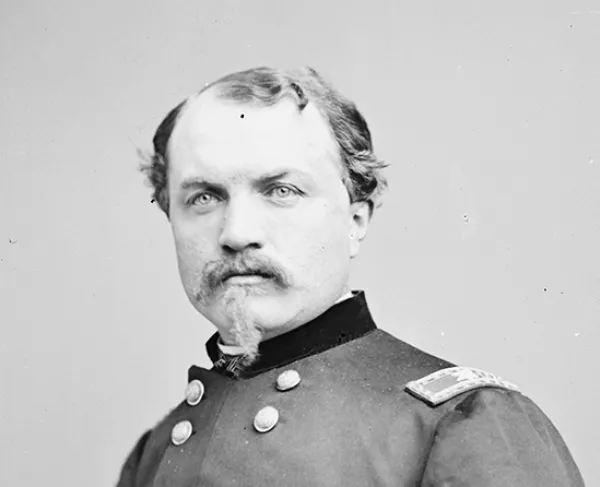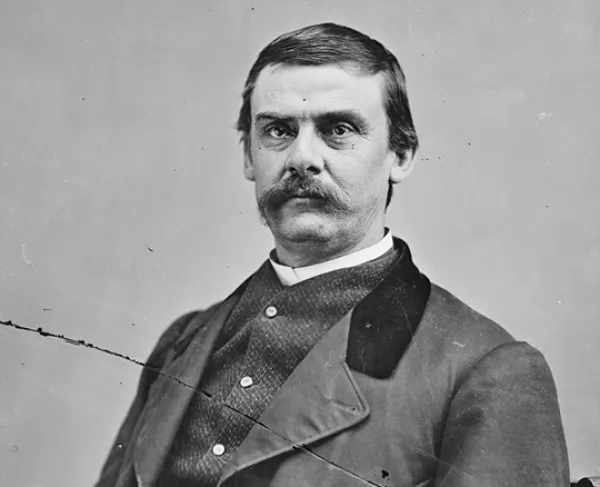
Droop Mountain
Pocahontas, WV | Nov 6, 1863
On November 6, 1863, Federal forces under William Averell defeated Confederates under the command of John Echols at the Battle of Droop Mountain, ending organized Southern resistance in West Virginia. The engagement was one of the largest and last major battles in West Virginia.
How It Ended
Union Victory. After fighting for several hours, Echols received word that overwhelming Federal forces were threatening his flanks. After this, he received more news that a Federal force was about to threaten his escape route. Not wanting his army to be encircled and destroyed, Echols decided to withdraw back into Virginia.
In Context
Despite West Virginia entering the Union in 1863, Confederate forces still maintained a presence in the region. This presence was largely due to the Virginia and Tennessee Railroad that ran beside the state's southeastern border. As long as the railroad remained in operation, a Confederate army could stay in West Virginia. By the fall of 1863, Union Department of West Virginia commander General Benjamin F. Kelly ordered Brigadier General William W. Averell to attack this rail line with the main goal of capturing Lewisburg, Virginia. Averell was the best man for the job since, in the months prior, he and his brigade had already launched raids into the region; however, he had failed to gain any serious advantage. To aid Averell's advance, Kelly assigned a mounted brigade under Union General Alfred N. Duffie to help capture Lewisburg.
The overall Federal plan was to have Averell's brigade draw the Confederates away from Lewisburg and Duffie to occupy the abandoned city and help capture the Confederate army. From there, they could attack the unguarded rail line and thus drive Sothern forces from the region.
Averell's column of nearly 5,000 men left Beverly, West Virginia, on November 1st and met no enemy for the first few days of the raid. On November 3rd, Duffie's column left Charleston and moved towards Lewisburg. By November 4th, Averell's men ran into elements of William L. Jackson's command near Hillsboro. After the skirmish, Jackson informed Echols of the Federal advance. After fighting a series of delaying actions, Jackson's command fell back to the summit of Droop Mountain on the 5th, just outside of Hillsboro. After receiving word of the need for reinforcements, Echols moved his brigade towards Droop Mountain. After a long night march, Echols men arrived in the area early on November 6th. Seeing that the Federals could potentially use the road from Fallings Springs to Hillsboro to attack the Confederate right and their route of escape, Echols left a small force to defend the road.
Early on the morning of the 6th, Averell left his camps near Mill Point and moved toward the Confederate positions on Droop Mountain. Averell’s plan of attack was to send a force to divert the Confederate attention to the Federal left and send the main attack on the Federal right, which was on top of the mountain. Once in position, Averell began to bombard the Southern lines around 11:00 am but inflicted little damage. By 1:45 pm, Averell’s right wing struck the Confederate left. Seeing that the Federals on the right were in action, Averell ordered his remaining three regiments to attack the Confederate center on Droop Mountain. The Federals charged up the mountain and faced deadly fire from the Southerners above. After reaching the Confederate lines, brutal hand-to-hand combat ensued in which the Federals were victorious. Around the same time, Federals on the right began steadily pushing back the Confederates.
To help buy time, Echols detached Colonel George S. Patton to the Confederate center, where he temporarily stopped the Federal advance. However, around 3:00 pm, Averell received word from his signal corps of the fledgling Confederate line and decided to move his last reserve on the Confederate left. Echols’ men were soon overrun and began to fall back.
119
275
By 4:00 pm, the battle was over, with the Confederates falling back towards Lewisburg. To make matters worse, Echols received word that Duffie’s column was only 18 miles from Lewisburg, which was lightly defended. After a grueling night march, Echols managed to get to Lewisburg. However, due to the condition of his men, Echols decided to fall back further south toward the Virginia border. Though the Federals captured Lewisburg, they failed to capitalize on their success and stopped at the town. Since Echols’ army escaped capture or destruction, the affair was considered a failure since the Virginia and Tennessee Railroad remained in operation.
Droop Mountain was the largest battle in West Virginia and was one of the last major battles during the war. Averell led a final raid on the Virginia-Tennessee Railroad that proved successful the following month. After Droop Mountain, all Confederate attempts to control West Virginia ended.
In and among the ranks of the Confederates at the Battle of Droop Mountain was Colonel George S. Patton Sr. Patton had previously defeated Averell in the Battle of White Sulpher Springs in the summer of 1863, which ended his first raid on the Virginia and Tennessee Railroad. Patton, during the battle, was critical in buying the Confederates enough time to get their artillery out of the area and supply wagons. Patton went on to fight in the Shenandoah Valley campaign of 1864, where he met his end at the Battle of Third Winchester. Patton’s grandson, named in his honor, George S. Patton Jr., became a famous general during World War II, leading American troops in North Africa, Sicily, and Europe.
During the Civil War, Union and Confederate armies used signal flags to relay quick information over long distances. For example, at the Battle of Droop Mountain, a detachment from the signal corps from the 68th New York Infantry was present during the battle. The detachment was assigned to follow the Federal attack on the Confederate left, which was on top of the mountain. During the pivotal moment of the battle, one member relayed information to Averell about the fledgling Confederate lines, which allowed him to drive home a final attack on the Confederate right, resulting in a Federal victory.
Droop Mountain: Featured Resources
Related Battles
5,000
1,700
119
275










